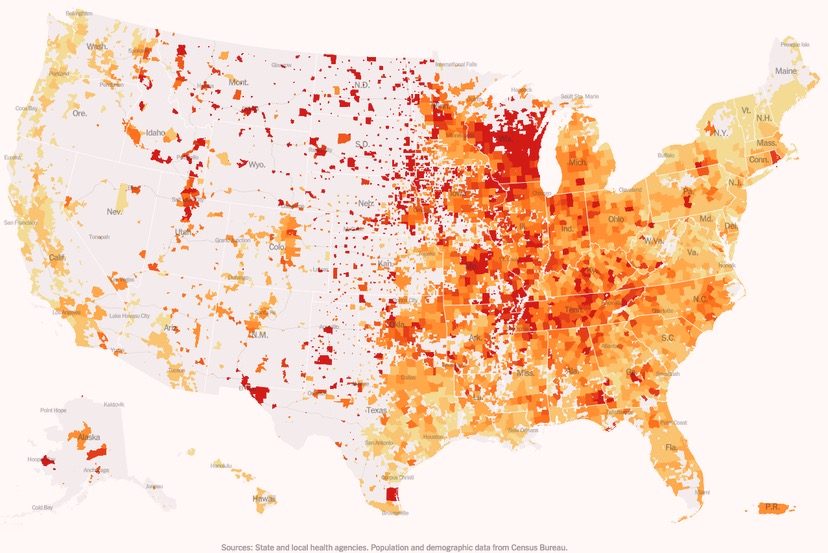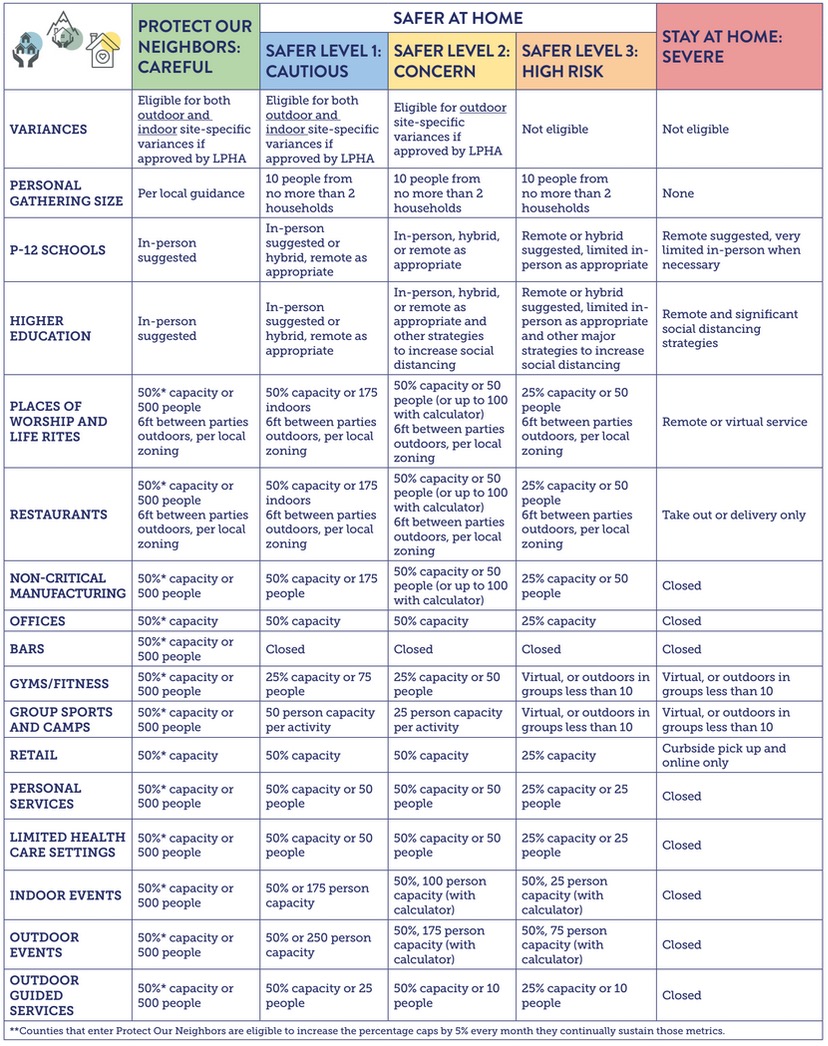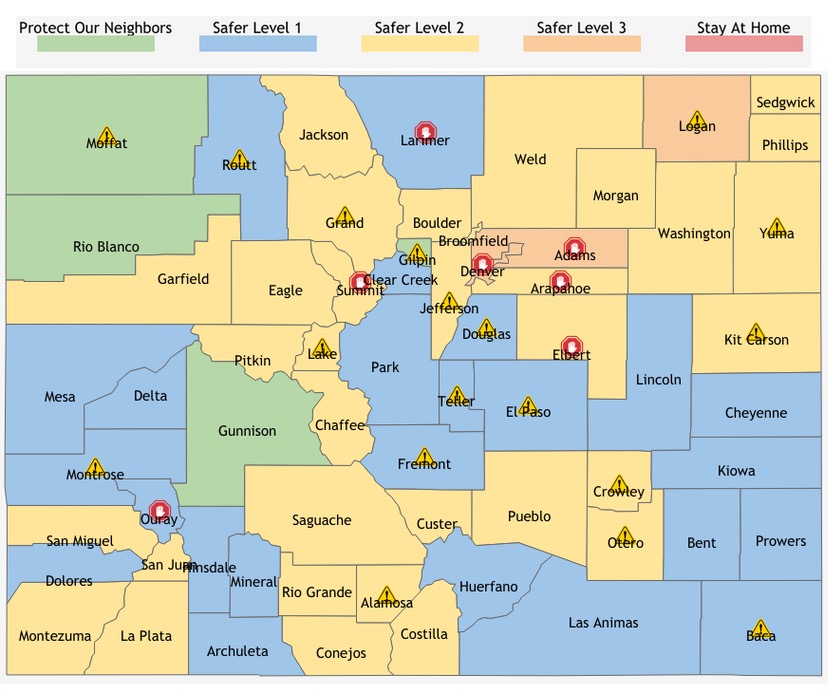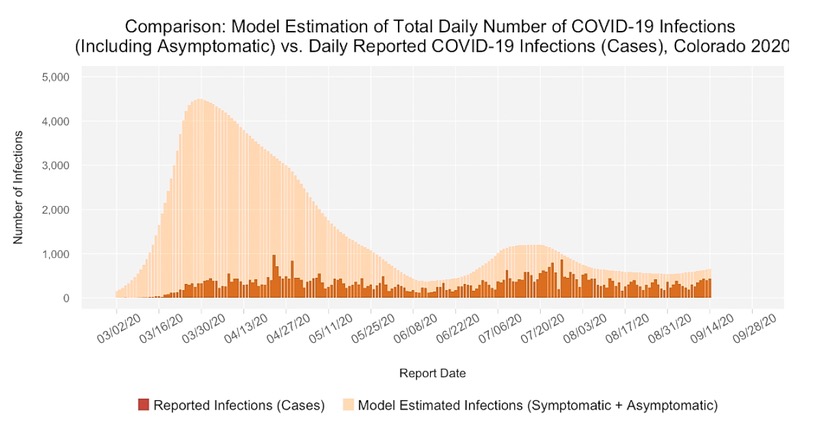Earlier this week, the Colorado Department of Public Health and Environment (CDPHE) announced that certain Colorado counties are “moving to stricter levels on the state’s COVID-19 dial.” Confirmed cases in several Colorado counties have been increasing over the past two weeks, putting pressure on hospitals and other facets of the state’s health care system. The counties have submitted mitigation plans to the CDPHE and are working to reverse the concerning trends in their communities.
The dial framework has five ‘capacity’ levels that guide a county’s response to COVID-19. Capacity restrictions for businesses, restaurants, schools, places of worship, and other locations vary based on a county’s dial level. The following counties will move ‘backwards’ on the dial this week, and will see increased limitations on businesses and gatherings:
Adams County and Denver County are moving to Safer at Home Level 3 (High Risk)
La Plata County, Arapahoe County, Otero County, and Crowley County are moving to Safer at Home Level 2 (Concern)
Mesa County moved to Safer at Home Level 1 on Monday (Cautious)
Archuleta County remains unchanged, at Safer at Home Level 1.
All ‘Safer at Home’ levels limit personal gatherings to 10 or fewer people from no more than two households, and have various capacity limits for other activities. You can review this comparative chart of every ‘capacity’ level, below.
You can also download the same full-size list here, as a PDF file.
“We need everyone to stay vigilant. Colorado is experiencing a swift rise in cases right now that is worrisome,” said Jill Hunsaker Ryan, executive director, CDPHE. “As we head into winter and spend more time indoors, the virus is going to be harder to suppress. The dial is designed for the long haul, in an attempt to control infections based on local conditions. We are grateful for the cooperation of counties, and the seriousness with which they are taking their response.”
Colorado’s dial framework standardizes different levels of “openness” at the county level and enables counties to balance, to control COVID spread while balancing social and economic needs. As we all know, social and economic needs have been taking a back seat since March.
A county’s dial level is determined by three metrics:
- New cases: How much the virus is circulating in a county.
- Percent positivity: Whether there is sufficient COVID-19 testing to capture the level of virus transmission.
- Impact on hospitalizations: Whether hospitalizations are increasing, stable, or declining.
The framework is intended to help counties determine when and how they should move from one dial level to another. The COVID-19 dial includes five levels, from least to most restrictive. At Level 5, Stay at Home, citizens are advised to remain at home except for essential tasks; only ‘essential businesses’ are allowed to operate. Currently, no Colorado counties are at Level 5 (Severe).
The counties marked with a yellow triangle are involved in ‘mitigation’ efforts. The counties marked with a red Stop sign are “enforcing stricter health orders”.
You can get more information about the dial, and county levels, at this website, where you can also keep up-to-date with changes… as we move into flu season.
Colorado has thus far counted about 100,000 confirmed and possible COVID cases, with about 93,000 cases ‘confirmed’. The state has lost about 2,000 residents to COVID.
According to the New York Times, nearly all of the states showing the most serious increases in confirmed cases are west of the Mississippi. These states are showing in excess of 40 new cases per day, per 100,000 residents, over the past 7 days:
North Dakota (102 new cases per day per 100,000), South Dakota (101), Wisconsin (73), Montana (70), Wyoming (56), Idaho (49), Utah (47), Nebraska (44).
Colorado’s rate is shown as 28 new cases per day per 100,000 people. That’s totals about 1,400 new cases per day.
North Dakota has the highest per capita of cases and deaths of any state. According to Healthline.com, North Dakota officials “have become so overwhelmed that they have ended almost all contact tracing”.
In terms of sheer numbers, Texas still leads the way in new COVID-19 cases, according to Reuters. Texas reported 41,089 new positive tests last week, an increase of 15 percent from the previous week.
Then we have the New York Times map, from yesterday, showing the “Hot Spots” — counties where per capita infection rates are especially high, shown in the darkest red. As we can see, although many the western states are showing rising per capita rates, the infections appear to be highly localized in just a few counties, and in larger metropolitan areas.
Taking in the big picture, most the the American West looks pretty quiet.
CDPHE has not been sitting on their hands, however. They’ve been trying to figure out what’s working, what isn’t working, and where this whole thing is headed. Here’s an interesting CDPHE chart that shows some ‘modeling’ by researchers at the Colorado School of Public Health:
The Colorado School of Public Health has been modeling the course of the pandemic in the state, and have determined that the first wave of cases in the early spring was actually much, much higher than the official CDPHE numbers indicate — because we were not tracking ‘asymptomatic’ cases (shown in pale orange.) A lack of testing obscured the true number of infections, they believe.
The chart above, from a modeling report the School of Public Health team produced last month, indicated that actual cases were as much as 10 times greater in the spring than what was reported.
Presumably, the state is doing a better job capturing asymptomatic cases in official data, as we move into November.
We’ll give Governor Polis the last word.
“I know we are all very tired of the virus. Fatigue is setting in. That’s why we’re seeing these numbers increase. But the virus is not tired of us. It’s still deadly.”




